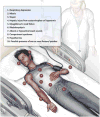Management of opioid analgesic overdose
- PMID: 22784117
- PMCID: PMC3739053
- DOI: 10.1056/NEJMra1202561
Management of opioid analgesic overdose
Conflict of interest statement
Dr. Boyer reports reviewing medical malpractice documents for CRICO (Controlled Risk Insurance Company) Vermont, MCIC Vermont, and PMSLIC (Pennsylvania Medical Group Management Association). No other potential conflict of interest relevant to this article was reported.
Figures




Comment in
-
Management of opioid analgesic overdose.N Engl J Med. 2012 Oct 4;367(14):1370-1; author reply 1372-3. doi: 10.1056/NEJMc1209707. N Engl J Med. 2012. PMID: 23034040 No abstract available.
-
Management of opioid analgesic overdose.N Engl J Med. 2012 Oct 4;367(14):1371; author reply 1372-3. doi: 10.1056/NEJMc1209707. N Engl J Med. 2012. PMID: 23034041 No abstract available.
-
Management of opioid analgesic overdose.N Engl J Med. 2012 Oct 4;367(14):1371-2; author reply 1372-3. doi: 10.1056/NEJMc1209707. N Engl J Med. 2012. PMID: 23034042 No abstract available.
-
Management of opioid analgesic overdose.N Engl J Med. 2012 Oct 4;367(14):1372; author reply 1372-3. doi: 10.1056/NEJMc1209707. N Engl J Med. 2012. PMID: 23034043 No abstract available.
References
-
- Okie S. A flood of opioids, a rising tide of deaths. N Engl J Med. 2010;363:1981–5. Erratum, N Engl J Med 2011;364:290. - PubMed
-
- Opioid analgesic risk evaluation and mitigation strategies (REMS): July 22-23, 2010 Joint Meeting of the Anesthetic and Life Support Drugs Advisory Committee and the Drug Safety and Risk Management Advisory Committee. Silver Spring, MD: Food and Drug Administration; 2010.
-
- Allen L, Kimura K, MacKichan J, Ritschel W. Committee for Pharmacokinetic Nomenclature of the American College of Clinical Pharmacology. Manual of symbols, equations & definitions in pharmacokinetics. J Clin Pharmacol. 1982;22:1S–23S. - PubMed
-
- Larson AM, Polson J, Fontana RJ, et al. Acetaminophen-induced acute liver failure: results of a United States multicenter, prospective study. Hepatology. 2005;42:1364–72. - PubMed
-
- Paulozzi LJ, Budnitz D, Xi Y. Increasing deaths from opioid analgesics in the United States. Pharmacoepidemiol Drug Saf. 2006;15:618–27. - PubMed
Publication types
MeSH terms
Substances
Grants and funding
LinkOut - more resources
Full Text Sources
Other Literature Sources
Medical
